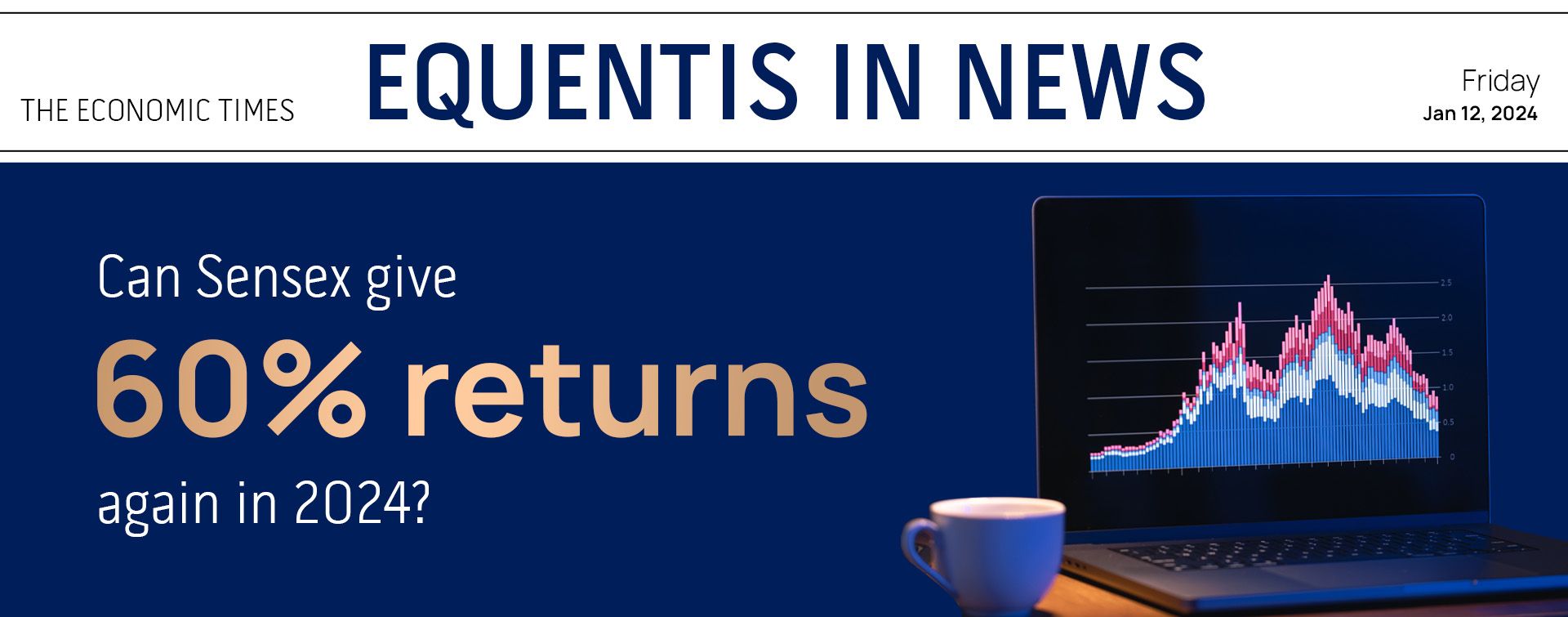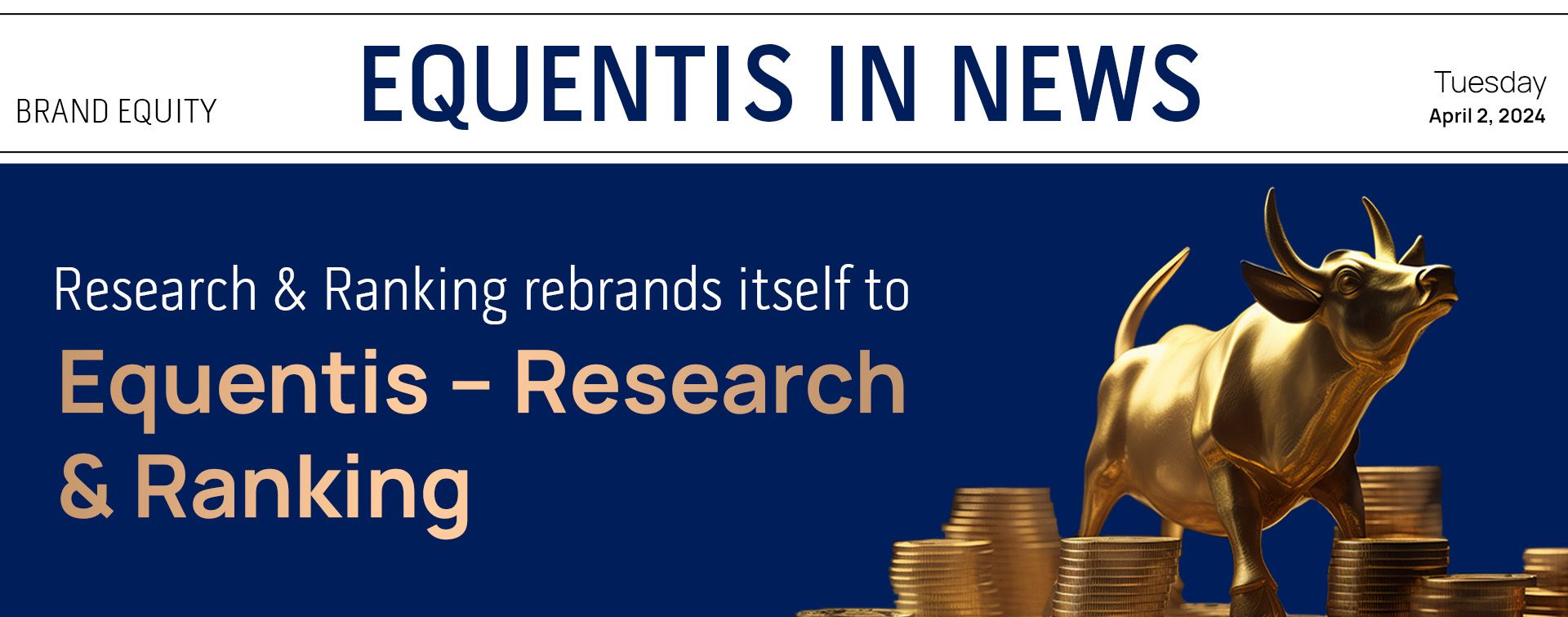Investment advisory offerings
Meet our leaders
Board members & management team of our stock market advisory
Testimonial
Elite Club
Our business of investment advisory services
Building trusted relationships
What’s in it for you
Discover cool features of our share market advisory services

Media
The media never fails to feature us!
Glimpses of our share market advisory
Explore our exclusive video gallery & brand films
FAQs on stock investment advisory
Get answers to the most pertinent questions on the stock market
An investment advisory offers personalized advice on managing your investments. Partnering with an investment advisory helps ensure that your financial goals align with market trends, offering peace of mind and strategic growth.
Yes, Equentis Research & Ranking, a fintech platform, is a part of Equentis Wealth Advisory Services Limited. It is a SEBI-registered Investment Advisory Services Company with Registration No.: INA000003874. We provide specialized stock advisory services, offering professional advice and guidance for investing in the Indian stock market.
A SEBI-registered investment advisor is a smart choice if you plan to invest in the stock market and need reliable advice. With so many investment advisors out there, it can take time to find the reliable long-term stocks.
However, SEBI-registered investment advisors prioritize your financial well-being above all else. They offer unbiased investment guidance and adhere to SEBI regulations, ensuring transparency and accountability, which help you to trust them with your investments.
A share market advisor provides guidance on buying and selling stocks based on market data. A reliable share market advisor ensures that your investments align with current market trends for maximum returns.
No, they are not the same. Investment advisory focuses on advising about buying and selling stocks. On the other hand, wealth management is more comprehensive, covering various financial services such as portfolio management, estate planning, and tax planning.
An investment advisor like Equentis Research & Ranking helps you to make smart investment decisions in the stock market, considering your long-term financial objectives. Our experienced team of advisors will provide the guidance you need to reach your financial objectives.
It is essential to understand the distinction between financial advisory and financial planning. While the terms are often used interchangeably, they have different meanings. A financial advisor is a broad category that includes professional investment advisors who offer advice on stock market investing.
On the other hand, a financial planner is a professional who helps individuals and organizations create a strategy to meet their long-term financial goals. This includes budgeting, saving, investing, and retirement planning. It's worth noting that all financial planners are financial advisors, but not all financial advisors are financial planners.
With so many financial advisors and planners, it's important to do your homework and find the right investment advisor to guide you. By understanding the differences between financial advisory and financial planning, you'll be better equipped to make an informed decision.
It's never too early to talk to a financial advisory. The best time to start talking to a financial advisory is once you have identified your financial goals. An experienced investment advisor can help you develop a sound strategy based on your risk profile and investment goals, considering tax implications and market conditions. With their expertise, an advisor can help you achieve your goals promptly and efficiently.
They can guide how to manage your portfolio best, which stocks are worth investing in, and advise when it might be beneficial to make changes.
Moreover, it depends on your circumstances, but investing can be a great way to build long-term wealth, make investment decisions, track the basics, and provide tailored advice that meets your risk profile and investment objectives. Talking to a financial advisory sooner rather than later can help you get more out of your investments. They can also guide you on when to enter or exit specific investments and markets.
Financial planning involves thoroughly evaluating one’s income, spending, debt, savings, and expectations for the future. You can create a plan independently or with the help of a certified financial planner. It may also involve investment advisory services to help individuals understand how to invest and create wealth.
Investors can benefit significantly from financial planning, enabling them to set clear short-term and long-term financial goals. With a financial plan, investors can make smart investments to achieve their objectives. A well-crafted financial advisory plan can help investors prioritize crucial immediate steps, such as reducing debt, building an emergency fund, and creating wealth.
An Investment Advisor plays a pivotal role in the Financial Planning process by providing professional guidance on your investment management. They analyze market trends, evaluate risk tolerance, and develop investment strategies tailored to align with your financial goals.
By leveraging their expertise in Indian stock market trends and smart investment practices, they offer personalized investment advisory services. This ensures you receive well-informed recommendations for the long-term stocks, including potential high-growth stock recommendations. This collaborative approach empowers you to make informed decisions and achieve financial objectives.
Technology revolutionizes the Financial Planning experience by offering efficient solutions and timely insights. With advanced tools, investment advisory services become more accessible and transparent. User-friendly interfaces update you on the latest stock market trends and investment opportunities.
Smart investment platforms enable real-time tracking and analysis, empowering investors to make swift decisions. By harnessing technology, investment advisors enhance the accuracy of stock market investing, ensuring you receive the best guidance for effective Financial Planning.
Effective Financial Planning hinges on several key considerations. First, understanding your risk tolerance and financial goals is crucial. An investment advisor assesses these factors to provide tailored investment advisory services. Second, a firm grasp of Indian stock market trends is essential for informed decision-making.
The investment advisory company leverages its expertise to offer potential high-growth stock recommendations and identify reliable long-term stocks. Finally, consistent monitoring and adjustments ensure your investments align with your objectives. By incorporating smart investment strategies, you can confidently navigate the stock market and achieve optimal results.
A Stock market advisor analyzes market trends and offers advice tailored to your investment needs. Working with a stock market advisor can significantly improve your portfolio's performance by focusing on high-potential stocks.
Share market advisory services offer in-depth analysis and recommendations for your stock investments. By using share market advisory services, you gain access to research-based insights that can help you make more informed investment decisions.
Investment advisory services focus on providing tailored investment strategies, while investment advisor services are more focused on offering individual stock advice. Both investment advisory services and investment advisor services work to enhance your financial outcomes.
A SEBI registered advisor follows strict regulations, ensuring transparency and ethical practices in their investment advisory services. Partnering with a SEBI registered advisor guarantees more trust and accountability in managing your investments.
A stock advisory company offers research-based insights and stock recommendations that align with your financial goals. By partnering with the a stock advisory company, you ensure your portfolio benefits from the latest market trends.
A registered investment advisor near me provides local expertise and personalized guidance for managing stock portfolios. Working with a registered investment advisor near me ensures that you receive tailored advice aligned with both local and global market conditions.
When selecting stock advisory services, consider factors such as market expertise, past performance, and the firm’s reputation. Quality stock advisory services will help you make smarter investment decisions and optimize your stock portfolio.
A stock advisory company is a professional firm that provides expert guidance on stock market investments. These companies offer stock market advisory services, helping investors identify profitable stocks, manage portfolios, and make informed decisions. With in-depth research-based recommendations, they aim to maximize returns while minimizing risk. Many investment advisory firms are legally registered and work to protect investors' interests by offering personalized advice tailored to financial goals and market trends.
Yes, share market advisory services can be worth the money, especially for investors seeking expert guidance and research-driven insights. These services provide personalized advice on stock selection, portfolio management, and market trends, helping investors make informed decisions. With the support of a stock market advisory firm, you can potentially maximize returns while minimizing risks. The expertise and tailored strategies offered by investment advisory services are particularly valuable for those who may not have the time or resources to analyze the market independently.
Opting for a SEBI-registered share market advisory company ensures that you receive trustworthy, professional guidance that adheres to strict regulatory standards. These firms are governed by SEBI, which means they must follow compliance guidelines designed to protect investors' interests. A SEBI-registered investment advisory provides personalized, research-backed recommendations tailored to your financial goals, ensuring that your investments are managed with transparency and expertise. Choosing a registered advisory firm enhances your confidence in making informed investment decisions while ensuring legal protection and credibility.
When choosing a share market advisory company, it's crucial to consider several key factors. First, ensure the company is a SEBI-registered stock market advisory firm, as this ensures regulatory compliance and protection for your investments. Look for a strong track record of successful stock recommendations and positive client reviews to gauge the firm's credibility. A reliable stock market advisory should also offer research-based recommendations, providing data-driven insights to help you make informed decisions. Additionally, review the fee structure to ensure it offers value for the services provided. Lastly, prioritize firms that offer personalized strategies tailored to your financial goals and risk tolerance, ensuring you get advice suited to your unique investment needs.
They provide valuable insights and guidance tailored to each investor's level of expertise. For beginners, these services offer easy-to-understand, research-based recommendations that help navigate the complexities of the stock market. A stock market advisory can simplify stock selection, portfolio management, and risk assessment, making it easier for new investors to make informed decisions. For experienced investors, a share market advisory adds value by offering advanced tools, deeper market analysis, and personalized strategies. Even seasoned investors benefit from expert advice to identify new opportunities, optimize their portfolios, and stay updated on market trends. The combination of professional insights and personalized strategies makes share market advisory services essential for achieving long-term financial goals, regardless of the investor's experience level.
A stock market advisory company specializes in providing stock-related investment guidance, which differentiates it from other financial services. Key differences include:
- Focus on stock investments – Unlike general financial services, a stock market advisor primarily offers stock recommendations based on market research.
- SEBI registered advisor – Compliance with SEBI regulations ensures credibility and transparency in stock advisory.
- Investment advisory services – Tailored advice on stock selection, portfolio management, and risk assessment.
- Shares advisory services – Insights into individual stocks, market trends, and sector performance.
- Stock advisory company vs. wealth management – While wealth management covers various assets like real estate and fixed income, a stock advisory company focuses on equities.
- Stock investment advisor – Provides in-depth stock research, unlike traditional financial planners who cover broader financial planning.
- Stock market advisory services – Offer strategies for both short-term traders and long-term investors, differentiating them from general financial consultants.
- Registered investment advisor near me – Personalized investment plans based on market conditions rather than generic financial products.
A share market advisory is ideal for those looking for specialized stock recommendations, whereas other financial services may focus on broader financial planning, tax advisory, or insurance.
When selecting a share market advisor, consider the following factors to ensure they align with your investment goals:
- SEBI registered advisor – Verify their registration to ensure compliance and credibility.
- Investment advisory services – Assess whether they offer personalized stock recommendations based on your risk appetite.
- Stock market advisory services – Look for expertise in market research and trend analysis.
- Shares advisory services – Ensure they provide insights for both short-term trading and long-term investments.
- Stock advisory company – Check their experience in different market sectors.
- Investment advisory firm – Evaluate transparency in pricing and the absence of hidden charges.
- Stock investment advisor – Review their past performance and client testimonials.
- Registered investment advisor near me – Consider accessibility and the quality of customer support.
- Top 10 share market advisor in India – Compare multiple advisors based on their reputation and service offerings.
A well-researched stock advisory can help you make informed decisions and optimize your investment strategy.
There are various types of stock advisory services available, catering to different investment needs. Some of the key services include:
- Investment advisory services – Personalized stock recommendations based on risk tolerance and financial goals.
- Stock market advisory services – Comprehensive market analysis, trend forecasting, and investment strategies.
- Shares advisory services – Guidance on individual stocks, including entry and exit points.
- SEBI registered advisor – Compliance-backed advisory services ensuring transparency and reliability.
- Stock investment advisor – Expert insights on building and managing a stock portfolio.
- Stock advisory company – Research-based stock recommendations for short-term and long-term investors.
- Stock market advisory company – Provides insights into market trends, sector performance, and potential investment opportunities.
- Registered investment advisor near me – Localized advisory support for personalized investment guidance.
- Top 10 share market advisor in India – Well-established advisors offering various investment strategies.
Choosing the right stock advisory services depends on your investment goals, whether you seek short-term trading strategies or long-term wealth creation.
Yes, a stock advisory company can assist with long-term investments by providing research-backed recommendations and portfolio strategies. Here’s how they help:
- Investment advisory services – Tailored advice on selecting fundamentally strong stocks for long-term growth.
- Stock market advisory services – In-depth market research to identify potential multibagger stocks.
- Shares advisory services – Guidance on stock selection, asset allocation, and portfolio rebalancing.
- SEBI registered advisor – Ensures compliance with regulations and offers credible investment advice.
- Stock investment advisor – Helps in analyzing company fundamentals, financials, and future growth prospects.
- Stock advisory company – Provides sector-specific insights to align investments with long-term market trends.
- Investment advisory firm – Monitors market conditions and suggests adjustments to maintain a strong portfolio.
- Registered investment advisor near me – Personalized assistance based on financial goals and risk tolerance.
A well-structured investment advisory service can help build a sustainable, long-term portfolio, ensuring steady returns over time.
Shares advisory services provide expert guidance on stock selection, portfolio management, and market analysis to help investors make informed decisions. These services include:
- Investment advisory services – Personalized stock recommendations based on financial goals and risk appetite.
- Stock market advisory services – Research-driven insights on market trends, company fundamentals, and sector performance.
- SEBI registered advisor – Ensures compliance with regulatory standards, offering trustworthy investment guidance.
- Stock advisory company – Helps investors navigate market fluctuations with strategic recommendations.
- Stock investment advisor – Assists in identifying growth stocks, value stocks, and dividend-paying stocks.
- Investment advisory firm – Provides portfolio diversification strategies to minimize risks and maximize returns.
- Registered investment advisor near me – Offers localized support for investors seeking tailored financial advice.
- Stock market advisory company – Delivers expert analysis to support both short-term traders and long-term investors.
By leveraging shares advisory services, investors can make data-driven investment choices and optimize their stock market returns.
To find reliable stock market advisory services in your area, follow these steps:
- Check for a SEBI registered advisor – Ensure the advisory firm is registered with SEBI for compliance and transparency.
- Look for investment advisory services – Verify if they offer personalized stock recommendations based on your financial goals.
- Research stock advisory companies – Compare different stock market advisory companies based on their expertise and track record.
- Read client reviews – Check testimonials and feedback from investors who have used their shares advisory services.
- Evaluate stock investment advisors – Assess their experience, past performance, and research capabilities.
- Search for a registered investment advisor near me – Look for local advisors who provide in-person consultation or strong customer support.
- Compare top 10 share market advisors in India – Consider well-established firms known for their investment advisory services.
By choosing a stock advisory company with a solid reputation and SEBI registration, you can ensure reliable and research-backed investment advice.


 The Phoenix Mills Ltd. (PDF)
The Phoenix Mills Ltd. (PDF)
 Trending Sector
Trending Sector Top Losers
Top Losers Adani Ports and SEZ
Adani Ports and SEZ























































